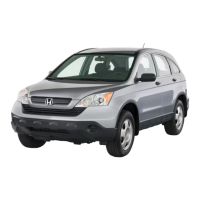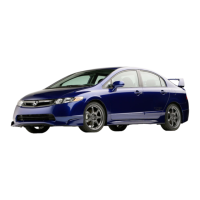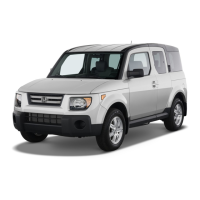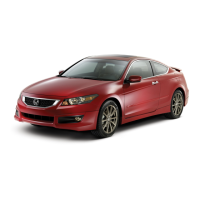Do you have a question about the Honda 2008 Fit and is the answer not in the manual?
Warning about chemicals known to cause cancer and birth defects or other reproductive harm.
Information about devices that record data related to vehicle accidents and their use.
Details on devices recording performance data for service and research purposes.
Safety information communicated via alert symbols, signal words (DANGER, WARNING, CAUTION), and specific messages.
Titles that highlight important safety topics like Important Safety Reminders or Safety Precautions.
Safety warnings and information found on labels placed on the vehicle.
Guidance on how to use the vehicle correctly and safely.
Key recommendations for safe operation, including seat belt use, child restraint, and vehicle condition.
Overview of built-in safety features designed to protect occupants during a crash.
Information on the importance, function, and proper use of seat belts for occupant safety.
Explanation of the Supplemental Restraint System (SRS), including front, side, and curtain airbags.
Guidance on proper seating positions, seat belt use, and adjustments for adults and teenagers.
Specific safety advice for pregnant drivers and passengers regarding seat belt use.
Further safety measures and warnings for occupants, including precautions regarding airbags and seating.
Essential guidelines for properly restraining infants, small children, and larger children in the vehicle.
Detailed instructions on selecting and installing child seats for infants and small children.
Criteria and recommendations for choosing the correct type and size of child seat.
Step-by-step procedures for securely installing child seats using seat belts or LATCH systems.
Instructions on how to properly secure a child seat using the vehicle's lap/shoulder belt system.
Guidance on using the tether strap and anchor points for added child seat security.
Information on seat belt fit, booster seat use, and precautions for larger children.
Warning about the dangers of carbon monoxide gas from vehicle exhaust and how to avoid exposure.
Locations and importance of safety warning labels found on the vehicle.
An overview of the main controls and their positions within the vehicle's interior.
Description of the instrument panel layout and its components.
Explanation of various warning and indicator lights on the instrument panel.
Details on the vehicle's gauges, including tachometer, speedometer, and fuel gauge.
Identification and function of controls located on or around the steering wheel.
Instructions on operating the windshield wipers, washers, and rear defogger.
How to operate turn signals, headlights, and fog lights.
Information on headlight operation, including high beams and daytime running lights.
How to adjust the illumination level of the instrument panel.
Function and use of the hazard warning (four-way flasher) button.
Operation of the rear window defogger to clear fog and frost.
How to adjust the steering wheel for optimal driving position and safety.
Information on vehicle keys, key number tags, and lock operation.
Explanation of the vehicle's anti-theft immobilizer system and its operation.
Description of the ignition switch positions and their functions.
How to operate the vehicle's power door locks and childproof door locks.
Instructions for opening, closing, and locking the vehicle's tailgate.
Operation of the remote transmitter for unlocking, locking, and panic functions.
Information on seat adjustments, reclining, folding, and head restraint positioning.
Operation of the vehicle's power windows, including auto functions.
Instructions for adjusting and using the inside and outside mirrors.
How to apply and release the parking brake, and related indicators.
Overview of various interior convenience features like coat hooks and beverage holders.
Operation of interior lights, including ceiling light and accessory power socket.
Detailed explanation of the climate control system, including vents, heating, and air conditioning.
Instructions on tuning, selecting, and playing AM/FM radio stations.
Factors affecting radio signal quality and reception, including atmospheric and environmental conditions.
How to load, play, and navigate tracks on CDs, CD-Rs, CD-RWs, MP3s, and WMAs.
Common error messages from the disc player and their solutions.
Guidelines for handling, cleaning, and storing discs to prevent damage and ensure proper playback.
How to connect external audio devices using the auxiliary input jack.
Explanation of the anti-theft system that requires a code to enable the audio system.
Step-by-step instructions for setting the vehicle's clock.
Information about the vehicle's anti-theft security system and its operation.
How to use the cruise control system for maintaining a set speed.
Recommendations for the first 600 miles (1,000 km) to ensure vehicle reliability and performance.
Guidance on the type of gasoline and fuel additives recommended for optimal engine performance.
Steps for refueling and interacting with service station equipment.
Instructions on how to properly refuel the vehicle's fuel tank.
Procedures for safely opening and closing the vehicle's hood.
How to check the engine oil level and add oil if necessary.
How to check the engine coolant level in the reserve tank and radiator.
Information on EPA fuel economy estimates, factors affecting it, and how to calculate it.
Information about genuine Honda accessories and potential issues with non-Honda accessories.
Guidelines for using the vehicle's storage areas and safely carrying cargo.
Tips for optimal handling and performance, cautioning about ground clearance and rough roads.
Essential checks and adjustments to perform before operating the vehicle.
Procedures for starting the engine under various conditions, including cold weather and potential flooding.
Instructions on operating the manual transmission, including shifting and using the clutch.
Explanation of the automatic transmission shift lever positions and operation.
How to use the paddle shifters for manual gear selection in Sport mode.
Proper procedures for parking the vehicle, including using the parking brake and considering inclines.
Overview of the hydraulic braking system, its design, and brake pad wear indicators.
Explanation of the ABS system, its operation, indicators, and important safety reminders.
Information on the TPMS, its indicators, and tire pressure maintenance.
Guidelines and warnings related to towing a trailer or towing the vehicle behind a motorhome.
Critical safety precautions and warnings to follow when performing maintenance.
Explanation of the maintenance minder system, engine oil life display, and service item codes.
Diagram showing the location of various vehicle fluid reservoirs.
Instructions on how to add engine oil, including recommended oil types and viscosity.
Procedures for changing the engine oil and oil filter, with safety and environmental notes.
Information on engine coolant, including type, checking levels, and adding coolant.
How to check and refill the windshield washer fluid reservoir.
Details on checking and refilling automatic and manual transmission fluid.
Instructions for checking brake and clutch fluid levels and replacement recommendations.
Information on headlight aiming and replacing various exterior and interior bulbs.
How to clean seat belts properly without damaging the fabric.
Guidance on using and anchoring genuine Honda floor mats to prevent pedal interference.
Advice on removing the antenna before using an automatic car wash to prevent damage.
Information on the dust and pollen filter, its replacement, and when it should be serviced.
How to check wiper blade condition and replace them when worn.
Instructions for cleaning wheels, with warnings about harsh chemicals and proper balancing.
Information on tire types, inflation, care, and inspection for wear and damage.
How to check the battery's condition using the test indicator and maintain terminals.
Guidelines for preparing the vehicle for extended storage to prevent deterioration.
Information on the compact spare tire, its limitations, and proper usage.
Step-by-step instructions for safely changing a flat tire using the vehicle's tools.
Troubleshooting steps for diagnosing and resolving issues when the engine fails to start.
Procedures and safety precautions for jump starting a vehicle with a dead battery.
What to do if the engine overheats, including safety warnings and diagnostic steps.
Explanation of the low oil pressure indicator and immediate actions to take.
Information on the charging system indicator and what to do if the battery is not being charged.
Meaning of the malfunction indicator lamp (check engine light) and related readiness codes.
Explanation of the brake system indicator light and related safety concerns.
Information on fuse box locations and procedures for checking and replacing fuses.
Guidelines for safely towing the vehicle, including proper procedures and warnings.
Instructions on how to free a vehicle stuck in sand, mud, or snow, including using the towing hook.
Location of vehicle identification numbers like VIN, engine, and transmission numbers.
Key vehicle specifications including dimensions, weights, engine details, and fluid capacities.
Explanation of DOT tire grading for treadwear, traction, and temperature performance.
How to read tire markings, including tire size and tire identification number (TIN).
Federal explanation of the TPMS, including tire pressure limits and malfunction indicators.
Overview of the vehicle's emissions control systems and their function.
Information on the catalytic converter, its function, maintenance, and protection.
Procedures for conditioning the vehicle to ensure readiness codes are set for emissions testing.
Contact information for customer service and how to resolve dealership issues.
Summary of various warranties covering the vehicle, including new vehicle, emissions, battery, and parts.
How to report potential vehicle safety defects to NHTSA and American Honda.
Information on how to purchase factory service, electrical, and body repair manuals.
Warning about chemicals known to cause cancer and birth defects or other reproductive harm.
Information about devices that record data related to vehicle accidents and their use.
Details on devices recording performance data for service and research purposes.
Safety information communicated via alert symbols, signal words (DANGER, WARNING, CAUTION), and specific messages.
Titles that highlight important safety topics like Important Safety Reminders or Safety Precautions.
Safety warnings and information found on labels placed on the vehicle.
Guidance on how to use the vehicle correctly and safely.
Key recommendations for safe operation, including seat belt use, child restraint, and vehicle condition.
Overview of built-in safety features designed to protect occupants during a crash.
Information on the importance, function, and proper use of seat belts for occupant safety.
Explanation of the Supplemental Restraint System (SRS), including front, side, and curtain airbags.
Guidance on proper seating positions, seat belt use, and adjustments for adults and teenagers.
Specific safety advice for pregnant drivers and passengers regarding seat belt use.
Further safety measures and warnings for occupants, including precautions regarding airbags and seating.
Essential guidelines for properly restraining infants, small children, and larger children in the vehicle.
Detailed instructions on selecting and installing child seats for infants and small children.
Criteria and recommendations for choosing the correct type and size of child seat.
Step-by-step procedures for securely installing child seats using seat belts or LATCH systems.
Instructions on how to properly secure a child seat using the vehicle's lap/shoulder belt system.
Guidance on using the tether strap and anchor points for added child seat security.
Information on seat belt fit, booster seat use, and precautions for larger children.
Warning about the dangers of carbon monoxide gas from vehicle exhaust and how to avoid exposure.
Locations and importance of safety warning labels found on the vehicle.
An overview of the main controls and their positions within the vehicle's interior.
Description of the instrument panel layout and its components.
Explanation of various warning and indicator lights on the instrument panel.
Details on the vehicle's gauges, including tachometer, speedometer, and fuel gauge.
Identification and function of controls located on or around the steering wheel.
Instructions on operating the windshield wipers, washers, and rear defogger.
How to operate turn signals, headlights, and fog lights.
Information on headlight operation, including high beams and daytime running lights.
How to adjust the illumination level of the instrument panel.
Function and use of the hazard warning (four-way flasher) button.
Operation of the rear window defogger to clear fog and frost.
How to adjust the steering wheel for optimal driving position and safety.
Information on vehicle keys, key number tags, and lock operation.
Explanation of the vehicle's anti-theft immobilizer system and its operation.
Description of the ignition switch positions and their functions.
How to operate the vehicle's power door locks and childproof door locks.
Instructions for opening, closing, and locking the vehicle's tailgate.
Operation of the remote transmitter for unlocking, locking, and panic functions.
Information on seat adjustments, reclining, folding, and head restraint positioning.
Operation of the vehicle's power windows, including auto functions.
Instructions for adjusting and using the inside and outside mirrors.
How to apply and release the parking brake, and related indicators.
Overview of various interior convenience features like coat hooks and beverage holders.
Operation of interior lights, including ceiling light and accessory power socket.
Detailed explanation of the climate control system, including vents, heating, and air conditioning.
Instructions on tuning, selecting, and playing AM/FM radio stations.
Factors affecting radio signal quality and reception, including atmospheric and environmental conditions.
How to load, play, and navigate tracks on CDs, CD-Rs, CD-RWs, MP3s, and WMAs.
Common error messages from the disc player and their solutions.
Guidelines for handling, cleaning, and storing discs to prevent damage and ensure proper playback.
How to connect external audio devices using the auxiliary input jack.
Explanation of the anti-theft system that requires a code to enable the audio system.
Step-by-step instructions for setting the vehicle's clock.
Information about the vehicle's anti-theft security system and its operation.
How to use the cruise control system for maintaining a set speed.
Recommendations for the first 600 miles (1,000 km) to ensure vehicle reliability and performance.
Guidance on the type of gasoline and fuel additives recommended for optimal engine performance.
Steps for refueling and interacting with service station equipment.
Instructions on how to properly refuel the vehicle's fuel tank.
Procedures for safely opening and closing the vehicle's hood.
How to check the engine oil level and add oil if necessary.
How to check the engine coolant level in the reserve tank and radiator.
Information on EPA fuel economy estimates, factors affecting it, and how to calculate it.
Information about genuine Honda accessories and potential issues with non-Honda accessories.
Guidelines for using the vehicle's storage areas and safely carrying cargo.
Tips for optimal handling and performance, cautioning about ground clearance and rough roads.
Essential checks and adjustments to perform before operating the vehicle.
Procedures for starting the engine under various conditions, including cold weather and potential flooding.
Instructions on operating the manual transmission, including shifting and using the clutch.
Explanation of the automatic transmission shift lever positions and operation.
How to use the paddle shifters for manual gear selection in Sport mode.
Proper procedures for parking the vehicle, including using the parking brake and considering inclines.
Overview of the hydraulic braking system, its design, and brake pad wear indicators.
Explanation of the ABS system, its operation, indicators, and important safety reminders.
Information on the TPMS, its indicators, and tire pressure maintenance.
Guidelines and warnings related to towing a trailer or towing the vehicle behind a motorhome.
Critical safety precautions and warnings to follow when performing maintenance.
Explanation of the maintenance minder system, engine oil life display, and service item codes.
Diagram showing the location of various vehicle fluid reservoirs.
Instructions on how to add engine oil, including recommended oil types and viscosity.
Procedures for changing the engine oil and oil filter, with safety and environmental notes.
Information on engine coolant, including type, checking levels, and adding coolant.
How to check and refill the windshield washer fluid reservoir.
Details on checking and refilling automatic and manual transmission fluid.
Instructions for checking brake and clutch fluid levels and replacement recommendations.
Information on headlight aiming and replacing various exterior and interior bulbs.
How to clean seat belts properly without damaging the fabric.
Guidance on using and anchoring genuine Honda floor mats to prevent pedal interference.
Advice on removing the antenna before using an automatic car wash to prevent damage.
Information on the dust and pollen filter, its replacement, and when it should be serviced.
How to check wiper blade condition and replace them when worn.
Instructions for cleaning wheels, with warnings about harsh chemicals and proper balancing.
Information on tire types, inflation, care, and inspection for wear and damage.
How to check the battery's condition using the test indicator and maintain terminals.
Guidelines for preparing the vehicle for extended storage to prevent deterioration.
Information on the compact spare tire, its limitations, and proper usage.
Step-by-step instructions for safely changing a flat tire using the vehicle's tools.
Troubleshooting steps for diagnosing and resolving issues when the engine fails to start.
Procedures and safety precautions for jump starting a vehicle with a dead battery.
What to do if the engine overheats, including safety warnings and diagnostic steps.
Explanation of the low oil pressure indicator and immediate actions to take.
Information on the charging system indicator and what to do if the battery is not being charged.
Meaning of the malfunction indicator lamp (check engine light) and related readiness codes.
Explanation of the brake system indicator light and related safety concerns.
Information on fuse box locations and procedures for checking and replacing fuses.
Guidelines for safely towing the vehicle, including proper procedures and warnings.
Instructions on how to free a vehicle stuck in sand, mud, or snow, including using the towing hook.
Location of vehicle identification numbers like VIN, engine, and transmission numbers.
Key vehicle specifications including dimensions, weights, engine details, and fluid capacities.
Explanation of DOT tire grading for treadwear, traction, and temperature performance.
How to read tire markings, including tire size and tire identification number (TIN).
Federal explanation of the TPMS, including tire pressure limits and malfunction indicators.
Overview of the vehicle's emissions control systems and their function.
Information on the catalytic converter, its function, maintenance, and protection.
Procedures for conditioning the vehicle to ensure readiness codes are set for emissions testing.
Contact information for customer service and how to resolve dealership issues.
Summary of various warranties covering the vehicle, including new vehicle, emissions, battery, and parts.
How to report potential vehicle safety defects to NHTSA and American Honda.
Information on how to purchase factory service, electrical, and body repair manuals.
| Brand | Honda |
|---|---|
| Model | 2008 Fit |
| Category | Automobile |
| Language | English |












